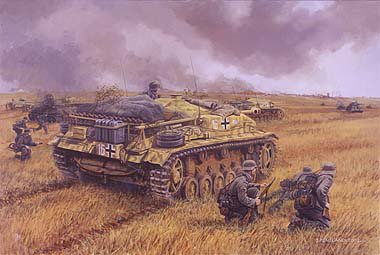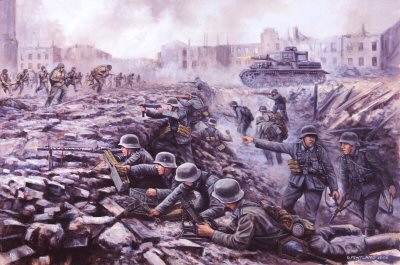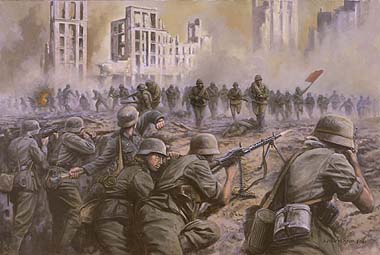The ferocious urban battle in Stalingrad
Battle on the Volga, Stalingrad, Southern Russia,
30th September 1942
Germany Infantry assault troops and PzIV tank of the 24th Panzer Division are counterattacked by Soviet riflemen of General Chuikovs 62nd Army as they push towards the Red October factory works.
In the first days of the fighting, the Germans were confident that although Stalingrad’s defenders fought fanatically from the beginning, they will quickly occupy the city. From the Russian side things didn’t look better. There were initially 40,000 troops in Stalingrad, but mostly ill-equipped reserve soldiers and those of the local population who were not evacuated, and it was assumed that Stalingrad might be lost in a few days. It was desperately clear to the Russian leadership that the only thing which could still save Stalingrad from falling, is a superb commander with a combination of the highest military skill and an iron will, and every possible reinforcement.
Actually two such commanders were selected and given the task of saving Stalingrad:
In the national level, Stalin ordered General Zhukov to leave the Moscow front and simply go to South Russia and save what he can. Zhukov, the best and most influential Russian General of World War 2, practically served as Stalin’s military “crisis solver”.
In the local level, General Vasily Chuikov, the deputy commander of the 64th army South of Stalingrad, and an aggressive and determined commander, was called to the regional command post. The severe situation was presented to him, and he was appointed the new commander of the Russian 62nd army, which still held most of Stalingrad. Before he left, he was asked “How do you interpret your mission?”. Chuikov’s answer was “We will defend the city or die”. His personal leadership during the following months, which projected catching determination and fatalism to Stalingrad’s defenders, shows that he meant it.
When General Chuikov came to Stalingrad, the 62nd army already lost half of its troops, and it was clear to its soldiers that it became a death trap, and many tried to escape across the Volga. General Chuikov knew that the only way to keep holding Stalingrad was to buy time with blood.
Stalingrad’s defenders were informed that the secret police guards all crossing points on the Volga, and everyone crossing the river without permission will be shot on the spot. In addition, a stream of fresh reinforcements, including elite units, began to arrive and cross the Volga under German fire into Stalingrad. Most were killed, but they enabled Chuikov to keep holding at least part of Stalingrad despite the tremendous German pressure. The average life expectancy of a reinforcement soldier in Stalingrad was as low as 24 hours !!. Whole units were sacrificed in Stalingrad’s desperate defence. One unit which perhaps sacrificed most in the battle of Stalingrad was the elite 13th Guards division, which was sent across the Volga into Stalingrad just in time to repel a German attack that reached the Volga near the center of the city. 30% of the 10,000 warriors of the 13th division were killed in the first 24 hours of their arrival, and only 320 survived the battle of Stalingrad, a horrible 97% death rate, but they saved Stalingrad in the most critical moment.
Soviet guards launch a Human Wave attack on beleaguered German defenders at Stalingrad,
Autumn 1942.
The concentration of forces and the intensity of the fighting in Stalingrad was unprecedented, with divisions attacking along a front line just a mile wide, or less. General Chuikov had to move his command post in the city from place to place to avoid being killed or captured, usually in the last possible moments.
Just sending more reinforcements to replace the dead was not enough. In order to reduce losses, Chuikov’s strategy was to narrow the gap between the Russian positions and the German positions to the absolute minimum, so close that the German Stuka dive bombers will not be able to drop their bombs on the Russian positions without risking the German soldiers. As a result, the fighting in Stalingrad was reduced to an endless series of small battles for every street, every building, every floor, and sometimes for every room in a building. Some key positions in Stalingrad changed hands up to fifteen times during the battle, with terrible bloodshed. The Russians had an advantage in night fighting among the ruined buildings and factories, sometimes using just knives or grenades instead of guns. The ruined city was a perfect killing zone for a large number of snipers, of both sides, including the head of the German army’s sniper school who was sent to Stalingrad to hunt the Russian snipers and was killed by one of them. Some highly successful Russian snipers became famous heroes. One of them killed 224 Germans by mid November.
The Russians nicknamed the city “the Stalingrad street fighting academy”. They also starved most of the time, because the German artillery made crossing the Volga so dangerous that what was shipped across the river was mostly more soldiers and ammunition, not food. Many Russian soldiers were killed while crossing the river to Stalingrad or while being evacuated back after being wounded in the city.
The German advantage in heavy fire by tanks and dive bombers was gradually matched by Russian artillery reinforcements of all types, from mortars to rocket launchers, which were concentrated East of the Volga, where the German tanks could not sweep them, and were protected from the Stuka dive bombers by many anti aircraft guns. The Russian Air Force also significantly increased its attacks, with much more aircraft than before and better trained pilots.
For the soldiers and few remaining civilians in Stalingrad, life, while they lasted, were an endless hell of gunfire, explosions, the yell sounds of dive bombers and Katyusha rockets, smoke, dust, rubble, hunger, the smell of death everywhere, and exhaustion and fear. It was like that day after day and week after week, and it also significantly raised disease rate.
At the end of October 1942, the Russians held only a narrow strip and some isolated pockets in Stalingrad, and the Germans tried one more major attack in an attempt to take it before winter, but the exhaustion and rising shortage of ammunition stopped them, but fighting continued.
Hitler, increasingly frustrated with the standstill, pushed more divisions closer to Stalingrad and into the city, further weakening the long German flanks in the empty prairies West and South of Stalingrad. He assumed that the Russians were consuming their last remaining reserves and that therefore a massive Russian attack in the German flanks was not expected. He was wrong.
The Russian counter attack
The Germans again underestimated the Russian resources. The continued weakening of the German flanks behind Stalingrad, as more and more German units were pushed to the city, was the anticipated opportunity for which General Zhukov prepared since the battle of Stalingrad began.
Also, like in the battle of Moscow a year before, the harsh Russian winter returned, sharply reducing the German army’s mobility and observation capabilities.
General Zhukov planned and prepared a massive Russian counter attack, code named operation Uranus, that would attack the German flanks at their two weakest points, 100 miles West of Stalingrad, and 100 miles South of it. The two Russian forces will meet far Southwest of Stalingrad and encircle the entire German 6th army near Stalingrad and cut its supply lines. It was a classic large scale Blitzkrieg plan, except that this time the Russians will do it to the Germans. Zhukov’s goal was to win not just battle of Stalingrad but the entire campaign in South Russia.
The Russian preparations covered every operational and logistical aspect. In maximum secrecy, over a million Russian soldiers were gathered, now greatly outnumbering the Germans, and 14,000 heavy artillery guns, 1000 T-34 tanks, and 1350 aircraft. Zhukov prepared a giant surprise attack, and when the Russian concentrations were finally noticed by the Germans at the end of October, it was almost too late to do anything, but the disbelief at the German side, and Hitler’s obsession, prevented them from significantly responding. When the German chief of staff suggested to abandon Stalingrad to shorten the German lines, Hitler shouted “I will not abandon the Volga!”.
The Russian counter attack began on November 19, 1942, three months after the battle of Stalingrad began. It was the first fully prepared Russian attack in World War 2, and it was a great success. The Russians attacked the sectors of the German flanks held by the 3rd and 4th Romanian armies. The Russians knew, from interrogating kidnapped POWs, that the Romanian forces had the lowest morale and least supplies.
Under the sudden pressure of the massive Russian artillery and advancing tank columns, the Romanian lines collapsed within hours, and after two days the Romanians surrendered. German units moved to face the advancing Russians, but it was too late, and in four days the two spearheads of the Russian pincer movement met each other about 100km West of Stalingrad.



